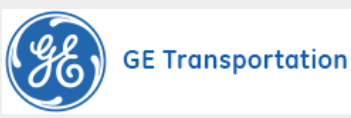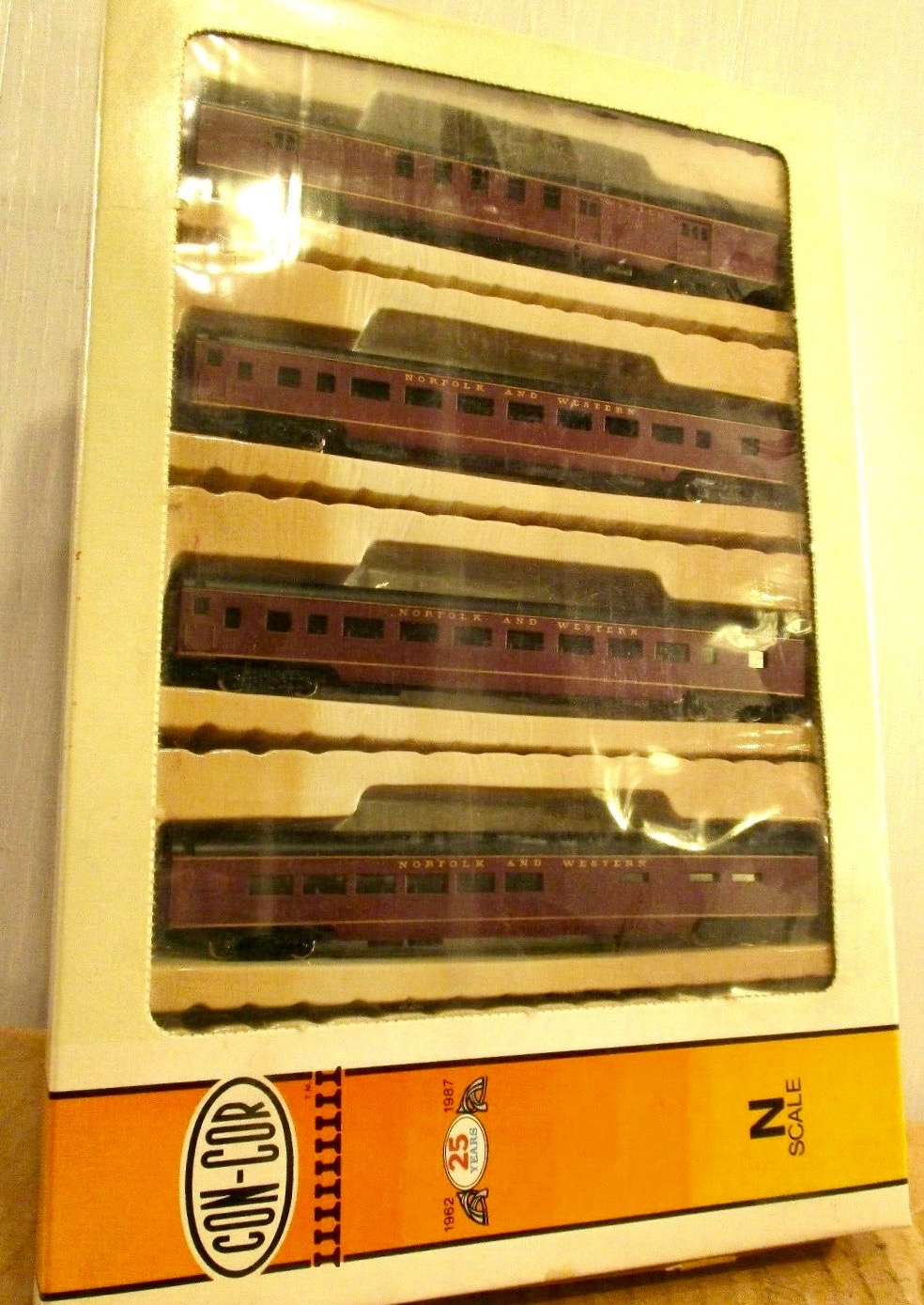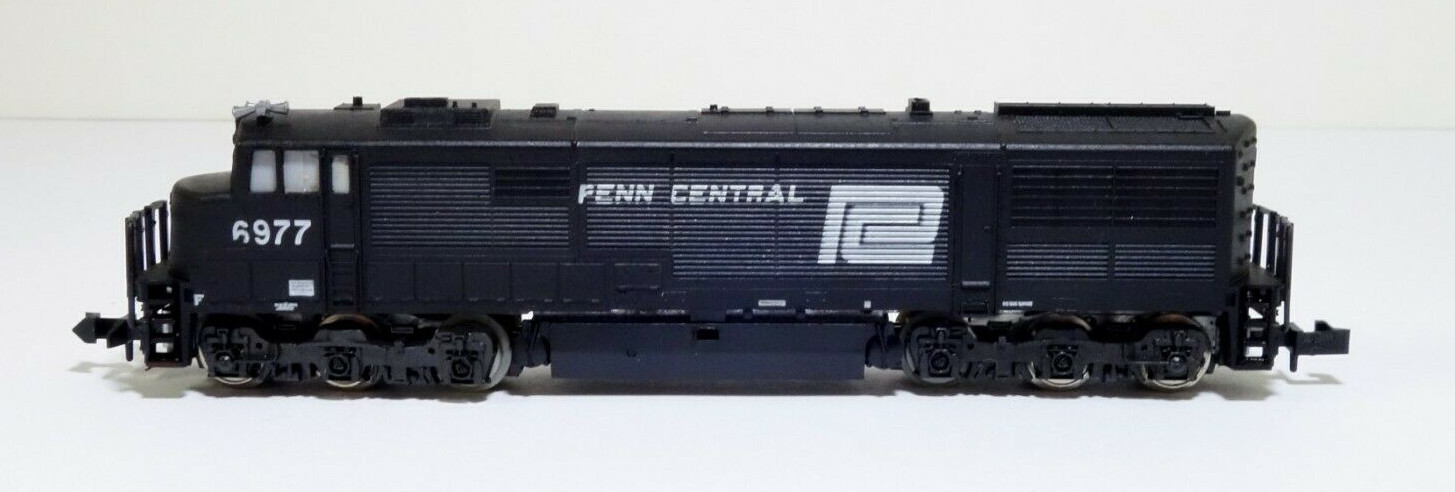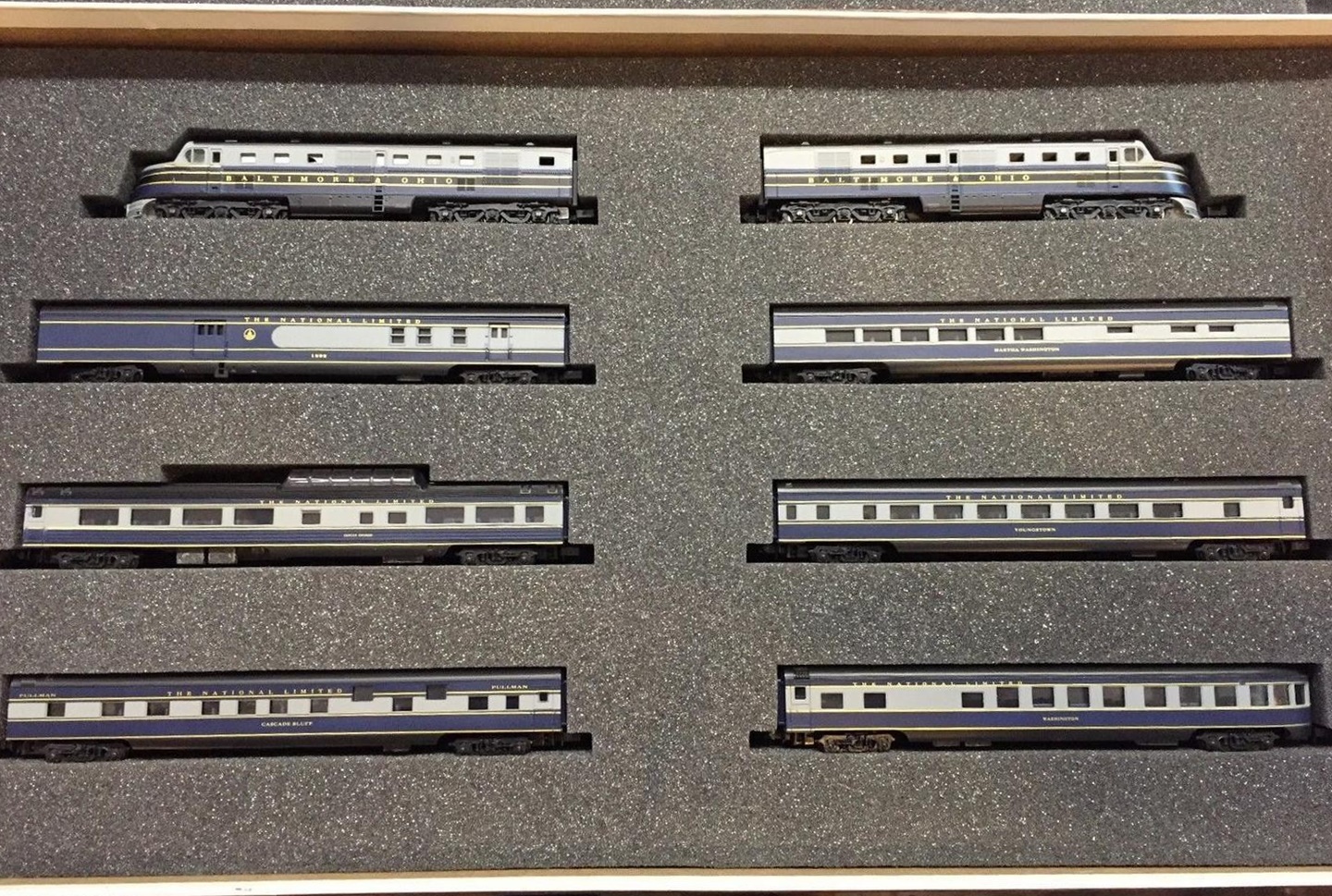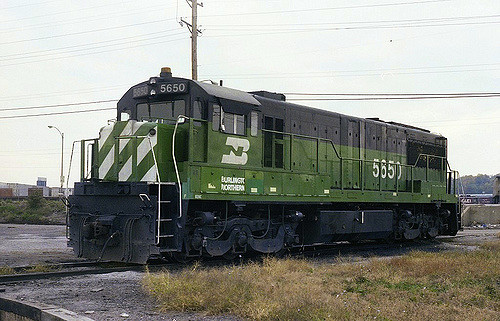Prototype History: The U28C was developed by General Electric from the U25C, with a slight increase in power of 300 hp (224 kW).[2] A passenger-hauling variant, the U28CG, was also produced for the Atchison, Topeka and Santa Fe Railway.
General Electric built ten uprated U25Cs in 1965. Facing the competitive pressure of the second generation horsepower race, GE built these units with increased horsepower. The competitive 2750 horsepower Alco C628 had more horsepower and the 3000 horsepower Alco C630 was announced in July 1965. General Motors had the 3000 horsepower EMD SD40 demonstrators testing on several railroads. The increase in unit horsepower was happening that year. The uprated units were built for three railroads that were already operating the U25C. The first uprated units were built for the Northern Pacific between May and July 1965. These were NP #2518-2520 and were rated at 2750 horsepower. Three more uprated U25Cs were built as Atlantic Coast Line #3011-3013 in December 1965. The ACL units were rated at 2800 horsepower. The last four uprated U25Cs were rated at 2800 horsepower and were built for the Pennsylvania Railroad in December 1965. These were PRR #6516-6519. Six additional PRR U25Cs were uprated to 2800 horsepower: 6500-6503, 6510-6511. In early 1966 General Electric began offering the 2800 horsepower U28C. A total of 28 look-a-like U28Cs were built between February 1966 and July 1966 as Chicago Burlington and Quincy #562-577 and Northern Pacific #2800-2811. These early Phase I U28Cs shared the 64 foot 4 inch frame that was standard with the predecessor U25C.
A drawing of the proposed longer frame U28C is in the November 1965 issue of Trains Magazine. Starting in May 1966 GE began producing the U28C on a longer frame. The new length for these U28Cs was 67 feet 3 inches. These are the 43 Phase II units built for Louisville and Nashville, Pennsylvania, Southern Pacific and Union Pacific. The Phase II units used either the General Electric GT 598 Generator or the GTA 9 Alternator. The 10 Santa Fe U28CGs were also built on this longer frame. Starting in November 1966 and through mid 1967 GE built 24 look a like Phase I U30Cs that used the same carbody as the Phase II U28Cs.
General Electric built ten uprated U25Cs in 1965. Facing the competitive pressure of the second generation horsepower race, GE built these units with increased horsepower. The competitive 2750 horsepower Alco C628 had more horsepower and the 3000 horsepower Alco C630 was announced in July 1965. General Motors had the 3000 horsepower EMD SD40 demonstrators testing on several railroads. The increase in unit horsepower was happening that year. The uprated units were built for three railroads that were already operating the U25C. The first uprated units were built for the Northern Pacific between May and July 1965. These were NP #2518-2520 and were rated at 2750 horsepower. Three more uprated U25Cs were built as Atlantic Coast Line #3011-3013 in December 1965. The ACL units were rated at 2800 horsepower. The last four uprated U25Cs were rated at 2800 horsepower and were built for the Pennsylvania Railroad in December 1965. These were PRR #6516-6519. Six additional PRR U25Cs were uprated to 2800 horsepower: 6500-6503, 6510-6511. In early 1966 General Electric began offering the 2800 horsepower U28C. A total of 28 look-a-like U28Cs were built between February 1966 and July 1966 as Chicago Burlington and Quincy #562-577 and Northern Pacific #2800-2811. These early Phase I U28Cs shared the 64 foot 4 inch frame that was standard with the predecessor U25C.
A drawing of the proposed longer frame U28C is in the November 1965 issue of Trains Magazine. Starting in May 1966 GE began producing the U28C on a longer frame. The new length for these U28Cs was 67 feet 3 inches. These are the 43 Phase II units built for Louisville and Nashville, Pennsylvania, Southern Pacific and Union Pacific. The Phase II units used either the General Electric GT 598 Generator or the GTA 9 Alternator. The 10 Santa Fe U28CGs were also built on this longer frame. Starting in November 1966 and through mid 1967 GE built 24 look a like Phase I U30Cs that used the same carbody as the Phase II U28Cs.
Road Name History: The Atchison, Topeka and Santa Fe Railway (reporting mark ATSF), often abbreviated as Santa Fe or AT&SF, was one of the larger railroads in the United States. Chartered in February 1859, the railroad reached the Kansas-Colorado border in 1873 and Pueblo, Colorado, in 1876. To create a demand for its services, the railroad set up real estate offices and sold farm land from the land grants that it was awarded by Congress. Despite the name, its main line never served Santa Fe, New Mexico, as the terrain was too difficult; the town ultimately was reached by a branch line from Lamy.
The Santa Fe was a pioneer in intermodal freight transport, an enterprise that (at one time or another) included a tugboat fleet and an airline (the short-lived Santa Fe Skyway). Its bus line extended passenger transportation to areas not accessible by rail, and ferryboats on the San Francisco Bay allowed travelers to complete their westward journeys to the Pacific Ocean. The ATSF was the subject of a popular song, Harry Warren & Johnny Mercer's "On the Atchison, Topeka and the Santa Fe", written for the film, The Harvey Girls (1946).
The railroad officially ceased operations on December 31, 1996, when it merged with the Burlington Northern Railroad to form the Burlington Northern & Santa Fe Railway.
Read more on Wikipedia.
The Santa Fe was a pioneer in intermodal freight transport, an enterprise that (at one time or another) included a tugboat fleet and an airline (the short-lived Santa Fe Skyway). Its bus line extended passenger transportation to areas not accessible by rail, and ferryboats on the San Francisco Bay allowed travelers to complete their westward journeys to the Pacific Ocean. The ATSF was the subject of a popular song, Harry Warren & Johnny Mercer's "On the Atchison, Topeka and the Santa Fe", written for the film, The Harvey Girls (1946).
The railroad officially ceased operations on December 31, 1996, when it merged with the Burlington Northern Railroad to form the Burlington Northern & Santa Fe Railway.
Read more on Wikipedia.
Brand/Importer Information: Trix is a German company that originally made Trix metal construction sets. one of its co-founders was Stephan Bing, the son of the pioneer toy-maker industrialist Ignaz Bing. In 1935 the company began producing the electrically powered model trains that it became famous for, under the Trix Express label. Prior to the outbreak of World War II the Trix company produced a small range of fairly unrealistic AC powered three rail models running at 14 volts.
N gauge models under the Minitrix brand were made from the late 1960s mostly of European prototypes (German and British primarily). North American prototypes were also manufactured and marketed under the Aurora "Postage Stamp" brand; later these items were sold under the American Tortoise, Model Power and Con-Cor brands. Trix sometimes utilized North American consultants to aid in the design of this portion of the product line. The "Hornby Minitrix' brand was used in the 1980s for a short lived range of British outline models using the earlier product tooling.
Trix's owner in the 1980s and 1990s was Mangold, which went bankrupt in the late 1990s and Märklin purchased the assets in January 1997. In part, this purchase was a reflection of Märklin's need for added production capacity; Trix had been manufacturing certain items for Märklin in previous years. The purchase was also in response to the earlier purchase of the Karl Arnold company by the Italian company Rivarossi; Märklin were very keen to take over Trix market share in 2-rail H0 and especially Minitrix, until then Märklin had not marketed N gauge models. In 2003, Märklin introduced its first N gauge models under the well established Minitrix brand. A number Märklin H0 scale three-rail AC locomotives have also been introduced in two-rail DC versions under the Trix logo and many models are shared between the two brands.
From Wikipedia
N gauge models under the Minitrix brand were made from the late 1960s mostly of European prototypes (German and British primarily). North American prototypes were also manufactured and marketed under the Aurora "Postage Stamp" brand; later these items were sold under the American Tortoise, Model Power and Con-Cor brands. Trix sometimes utilized North American consultants to aid in the design of this portion of the product line. The "Hornby Minitrix' brand was used in the 1980s for a short lived range of British outline models using the earlier product tooling.
Trix's owner in the 1980s and 1990s was Mangold, which went bankrupt in the late 1990s and Märklin purchased the assets in January 1997. In part, this purchase was a reflection of Märklin's need for added production capacity; Trix had been manufacturing certain items for Märklin in previous years. The purchase was also in response to the earlier purchase of the Karl Arnold company by the Italian company Rivarossi; Märklin were very keen to take over Trix market share in 2-rail H0 and especially Minitrix, until then Märklin had not marketed N gauge models. In 2003, Märklin introduced its first N gauge models under the well established Minitrix brand. A number Märklin H0 scale three-rail AC locomotives have also been introduced in two-rail DC versions under the Trix logo and many models are shared between the two brands.
From Wikipedia
Item created by: gdm on 2021-05-13 17:44:16. Last edited by gdm on 2021-05-13 17:44:33
If you see errors or missing data in this entry, please feel free to log in and edit it. Anyone with a Gmail account can log in instantly.
If you see errors or missing data in this entry, please feel free to log in and edit it. Anyone with a Gmail account can log in instantly.





